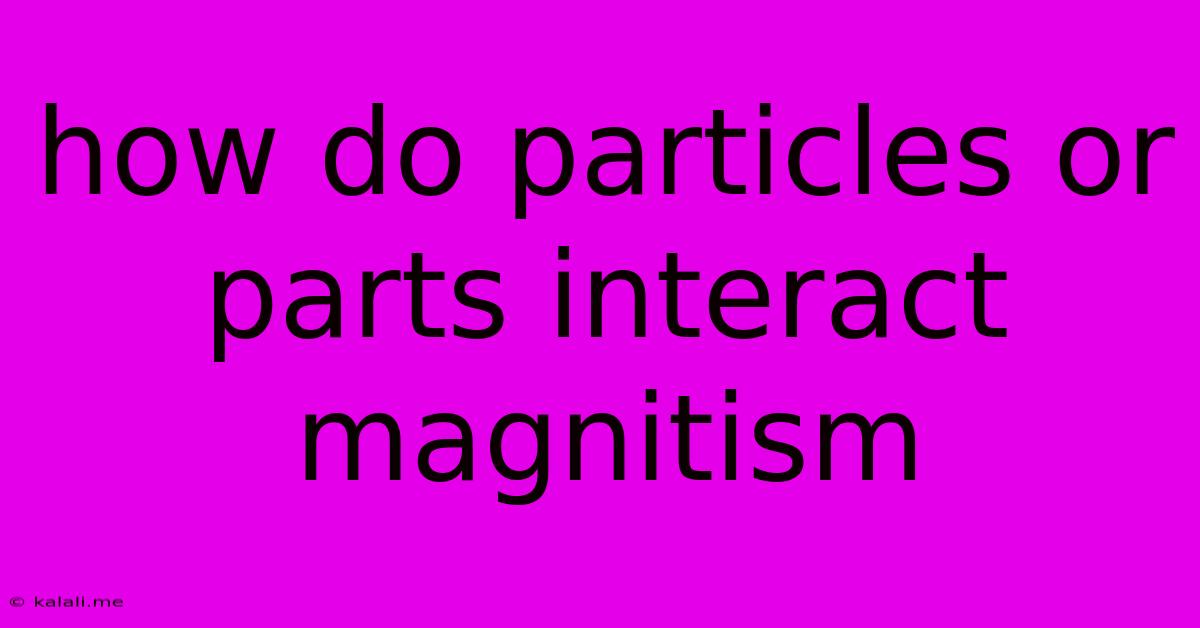How Do Particles Or Parts Interact Magnitism
Kalali
May 31, 2025 · 3 min read

Table of Contents
How Do Particles and Parts Interact with Magnetism?
Meta Description: Uncover the fascinating world of magnetism! This article explains how different particles and materials interact with magnetic fields, from fundamental atomic structures to everyday applications. Learn about ferromagnetism, diamagnetism, and paramagnetism.
Magnetism, a fundamental force of nature, governs the interaction between charged particles in motion. Understanding how particles and parts interact with magnetism requires delving into the atomic and subatomic world. It’s a complex topic, but we can break it down into manageable concepts to grasp the basics. This exploration will cover the essential principles and different types of magnetic interactions.
The Atomic Basis of Magnetism
At the heart of magnetism lies the electron, a fundamental subatomic particle possessing both charge and intrinsic angular momentum, known as spin. This spin generates a tiny magnetic field, acting like a miniature bar magnet. In most atoms, these electron spins cancel each other out, resulting in no net magnetic moment. However, in certain materials, the electron spins align, creating a macroscopic magnetic field.
Types of Magnetic Interactions
Several categories describe how materials interact with magnetic fields:
-
Ferromagnetism: This is the strongest form of magnetism. In ferromagnetic materials like iron, nickel, and cobalt, the electron spins within their atoms spontaneously align in regions called magnetic domains. When these domains align, the material exhibits a strong overall magnetic field. This alignment can be influenced by an external magnetic field, leading to magnetization. The process of aligning domains is crucial for creating permanent magnets.
-
Paramagnetism: Paramagnetic materials have atoms with unpaired electron spins. These spins are randomly oriented in the absence of an external magnetic field. However, when exposed to an external field, the spins tend to align with the field, resulting in a weak, temporary magnetization. This magnetization disappears when the external field is removed. Aluminum and oxygen are examples of paramagnetic materials.
-
Diamagnetism: Diamagnetism is a much weaker effect than ferromagnetism or paramagnetism. In diamagnetic materials, the electron spins are paired, and the material itself exhibits no net magnetic moment. However, when placed in an external magnetic field, the electrons generate a weak opposing magnetic field. This opposition is a result of Lenz's Law, which essentially states that a system will react to resist a change. Water and copper are diamagnetic materials.
Beyond the Basics: More Complex Interactions
Understanding the interaction between particles and magnetism extends beyond these three primary types. Factors such as temperature, material composition, and crystal structure significantly impact magnetic behavior. For instance, the Curie temperature is a critical point where a ferromagnetic material transitions to a paramagnetic state as temperature increases, disrupting the alignment of magnetic domains.
The study of magnetism also encompasses advanced concepts like:
- Antiferromagnetism: In antiferromagnetic materials, neighboring spins align antiparallel, resulting in no net magnetization.
- Ferrimagnetism: Similar to ferromagnetism, but with different magnitudes of spins in opposing directions, leading to a net magnetic moment. This is the case for many ferrites.
- Superparamagnetism: Observed in small nanoparticles where the magnetic domains fluctuate rapidly, behaving like paramagnetic materials but with stronger magnetization.
Practical Applications
The interaction of particles with magnetism underpins numerous technological applications:
- Data storage: Hard disk drives and magnetic tapes rely on the ability to magnetize and demagnetize tiny regions to store digital information.
- Medical imaging: MRI (Magnetic Resonance Imaging) utilizes the interaction of magnetic fields with atomic nuclei to create detailed images of the human body.
- Electric motors and generators: These devices harness the interaction between magnetic fields and moving charges to convert electrical energy into mechanical energy and vice versa.
In conclusion, the interaction between particles and magnetism is a rich and complex field. From the fundamental alignment of electron spins to the macroscopic properties of materials, understanding this interaction is crucial for numerous scientific and technological advancements. Further exploration into the quantum mechanical aspects of magnetism provides an even deeper understanding of this fascinating force.
Latest Posts
Latest Posts
-
How To Fix Loose Door Handle
Jun 01, 2025
-
Is It Illegal To Kill A Bear In Self Defense
Jun 01, 2025
-
Hope For The Best Prepare For The Worst
Jun 01, 2025
-
Higher The Better And Lower The Better Logo
Jun 01, 2025
-
How To Uninstall An D Reinstal Dlc Steamn
Jun 01, 2025
Related Post
Thank you for visiting our website which covers about How Do Particles Or Parts Interact Magnitism . We hope the information provided has been useful to you. Feel free to contact us if you have any questions or need further assistance. See you next time and don't miss to bookmark.